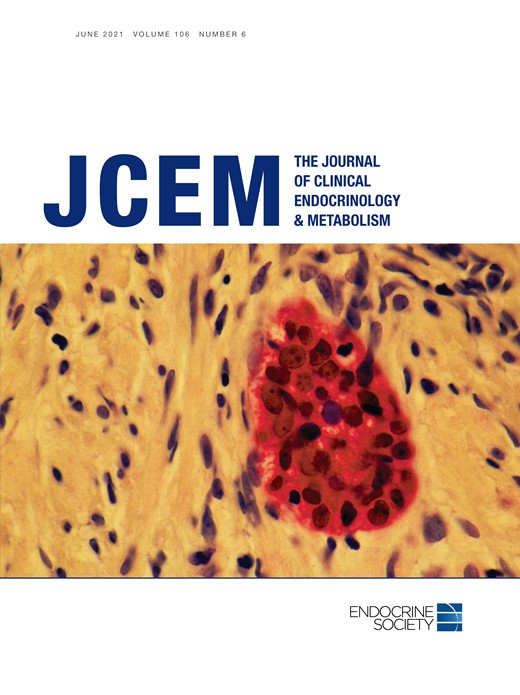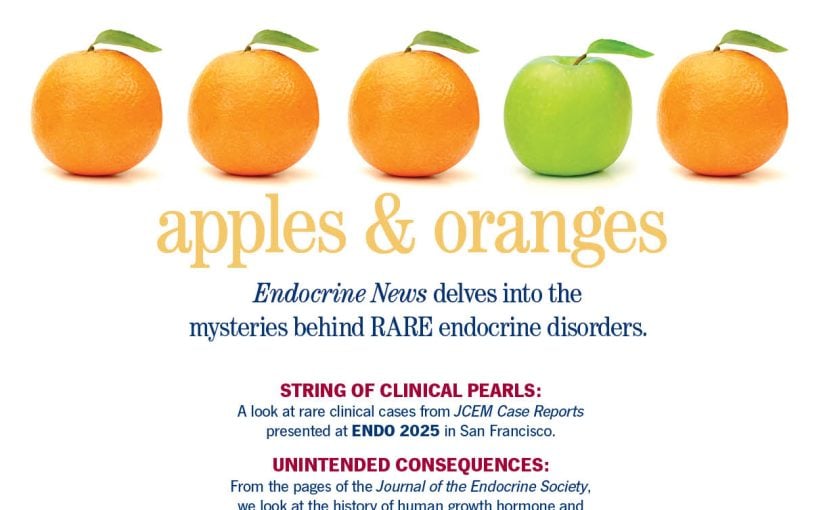The editors from The Journal of Clinical Endocrinology & Metabolism share their picks for the top breakthroughs in endocrine science from 2022.

Editor-in-chief of JCEM, Paul M. Stewart, MD, FRCP, FMedSci, executive dean and professor at the University of Leeds School of Medicine in the United Kingdom says he “wanted something of an evidence to a decision that flags a couple of great papers from the nearly 500 that JCEM publishes each year” and highlights two: “Effects of Tirzepatide, a Dual GIP and GLP-1 RA, on Lipid and Metabolite Profiles in Subjects with Type 2 Diabetes,” by Pirro, V. et al. from February, and “Randomized Trial of Osilodrostat for the Treatment of Cushing Disease,” by Gadelha, M. et al. from June. “For me, both highlight a real strength of JCEM — the publication of innovative phase 2 clinical studies that are multicenter in design, partnered with industry, informed by state-of-the-art experimental medicine, and that will undoubtedly shape future clinical practice,” Stewart says.
The first study describes the effect of the novel glucagon-like peptide 1 receptor (GLP-1R) agonist tirzepatide on lipid and metabolic profiles in patients with type 2 diabetes mellitus. “Highly effective in improving insulin action and often weight reduction, GLP-1Rs have become the standard care for many patients. Recent work has focused on dual agonists that, in addition to their action on the GLP-1R also stimulate the glucose-dependent insulinotropic polypeptide receptor (GIPR). In this double-blind placebo-controlled study involving over 300 patients and utilizing novel mass spectrometry -omic analyses, dual agonist therapy with tirzepatide significantly improved metabolomic and lipidomic profiles in addition to glucose control compared to placebo or GLP-1R agonist alone. Although the mechanisms are not yet fully understood this dual agonist approach offers the exciting possibility of reversing the metabolic dysregulation associated with type 2 diabetes mellitus while also addressing glucose control.”
“There has been an increasing amount of information about endocrine disruptors and their association with overall endocrine health and thyroid cancer in recent years. Many of the studies have evaluated agricultural or occupational exposure to pesticides. This article focuses on exposure that can occur within urban areas from residential pesticide exposure. This highlights the importance of further research in the area of endocrine disruptors and thyroid and other endocrine cancers.”
Whitney S. Goldner, MD, professor, Division of Diabetes, Endocrinology & Metabolism, at the University of Nebraska Medical Center, Omaha, Nebraska, on “Thyroid Cancer and Pesticide Use in a Central California Agricultural Area: A Case-Control Study,” by Omidakhsh et al. from the July 2022 JCEM
The second study demonstrates the effectiveness of osilodrostat, a potent oral inhibitor of 11b-hydoxylase, an enzyme involved in the final biosynthetic pathway of cortisol within the adrenal cortex. “Without control of hypercortisolism, Cushing syndrome has a high morbidity and mortality,” Stewart explains. “Although surgery remains the mainstay of treatment for most patients, up to one third of patients with the commonest cause pituitary-dependent Cushing syndrome (Cushing disease) are unsuitable for surgery or not cured postoperatively. Several drugs are licensed to treat such patients in an attempt to normalize cortisol hypersecretion, but to date all with variably efficacy. In this randomized placebo-controlled study of 73 patients with Cushing disease, osilodrostat normalized urinary free cortisol in 77% and 81% of patients receiving the drug after 12 weeks and 36 weeks, respectively. The drug was well tolerated with anticipated ‘side effects’ that we typically observe in patients undergoing ‘steroid withdrawal’.”
“These outstanding clinical studies highlighting the clinical benefit of new therapeutics have provided pivotal information to improve the management of our patients with type 2 diabetes mellitus and separately those with Cushing disease,” Stewart adds.
More from JCEM Editors

David J. Handelsman, PhD, professor of medicine, Concord Clinical School, ANZAC Research Institute, at the University of Sydney; Department of Andrology, Concord Hospital, in Australia
liked two JCEM hypogonadism papers. “Reproductive Phenotypes in Men with Acquired or Congenital Hypogonadotropic Hypogonadism: A Comparative Study” was published in June by Maione, L. et al. “This is a comprehensive, large study of congenital and acquired hypogonadotropic hypogonadism outlining their differences and will be a definitive reference for this condition,” Handelsman says. Stamou, M. I. et al. published “Prevalence and Phenotypic Effects of Copy Number Variants in Isolated Hypogonadotropic Hypogonadism” in July. “This large study describes the prevalence and impact of copy number variation as a genetic cause of congenital hypogonadotropic hypogonadism and brings to attention the importance of this overlooked genetic mechanism in this condition,” he says.
Elizabeth N. Pearce MD, MSc, Boston University School of Medicine, Section of Endocrinology, Diabetes, and Nutrition, Boston, Mass., says, “I opted to highlight two thyroid papers (since, as a thyroidologist, these are the ones I get most excited about). The first is the most highly cited thyroid trial in JCEM, and the second is the most highly cited JCEM thyroid paper overall.”
By Brose, M. S. et al., “A Randomized Study of Lenvatinib 18 mg vs 24 mg in Patients with Radioiodine-Refractory Differentiated Thyroid Cancer” came out in February. “The multikinase inhibitor lenvatinib has been shown to prolong survival in patients with advanced, non-radioactive iodine avid differentiated thyroid cancer,” Pearce says. “However, at the recommended starting dose of 24 mg daily, it is poorly tolerated, and most patients will require treatment interruptions or dose reduction. This randomized, blinded clinical trial in 152 patients aimed to determine whether starting lenvatinib at 18 mg/day leads to reduced toxicity and similar efficacy compared to the 24 mg/day dose. Disappointingly, this did not prove to be the case, as response to therapy at 24 weeks was significantly lower in the 18-mg/day group, and adverse effects did not differ. This trial clearly supports starting lenvatinib at the labeled 24-mg daily dose.”
Her second choice, “SARS-CoV-2 Vaccine-induced Thyroiditis: Safety of Revaccinations and Clinical Follow-up,” by Oğuz, S. H. et al. that came out in April, stands out despite being about COVID, which has been studied extensively the last two years. “It is now reasonably well established that both SARS-CoV-2 infection and SARS-CoV-2 vaccination may trigger subacute thyroiditis or Graves’ hyperthyroidism,” said Pearce. “This study was the first to address the very practical question of whether it is safe to provide repeated SARS-CoV-2 vaccination in patients who have already experienced vaccine-related thyroiditis. In this small series in which cases were meticulously defined, it is reassuring that only two of nine patients with prior vaccine-linked thyroiditis developed recurrent thyroiditis with subsequent vaccine doses.”
Sangeeta Kashyap, MD, professor of medicine; associate program director for Endocrinology, Diabetes and Metabolism Fellowship at the Cleveland Clinic Lerner College of Medicine in Ohio, also chose two JCEM papers. “Twin Study: Genetic and Epigenetic Factors Affecting Circulating Adiponectin Levels,” published in September by Hasegawa, M. et al., “highlights that fat hormones are under the influence of the environment thru epigenetic modifications and not just genetic factors that one would expect in monogenic twins.” Thanks to “Mapping Cord-Blood Transcriptome of Early Pregnancy Maternal Anemia to Identify Signatures of Fetal Programming” by Hatem, G. et al. in April, says Kashyap, “We have a better sense of which genes in fetal development are linked to diabetes from mothers with anemia.”
Raghu G. Mirmira, MD, PhD, professor of medicine; vice chair for research; director, Translational Research Center at the University of Chicago, Chicago, Ill., also gave two JCEM papers top billing. “Ketone Body Infusion abrogates Growth Hormone Induced Lipolysis and Insulin Resistance,” by Høgild, M. L. et al., was just published in October. “JCEM is known for publishing papers that alter our approach to clinical management of endocrine diseases. However, JCEM has also been one of the leading journals that publish basic physiologic observations and mechanisms of metabolism in humans. This study provides new insight into human metabolic disease. It has been observed that ketone body administration (notably β-hydroxybutyrate) reduces glucose and free fatty acid (FFA) levels in humans, but the underlying mechanisms, and if the two are linked, has remained unknown. In this study, the authors induced elevations in FFAs through infusion of growth hormone, along with infusions of either saline or β-hydroxybutyrate in healthy subjects. They studied insulin sensitivity using a clamp technique and followed glucose levels using a tracer. They found that the mechanism by which β-hydroxybutyrate reduces glucose levels is not a direct effect on improving insulin sensitivity, but a secondary effect via the suppression of FFAs. The authors hypothesize that this effect on FFA suppression might be mediated through the HCA2 receptor. This study provides an important new insight into the mechanism by which ketone bodies improve insulin resistance and lower blood glucose.”
From September, “Lower Blood Oxygen Saturation is Associated with Microvascular Complications in Individuals with Type 1 Diabetes,” by Laursen, J. C. et al., focuses on determinants of complications in the setting of type 1 diabetes, a topic that has received less attention compared to type 2 diabetes. “Nevertheless,” Mirmira says, “complications such as retinopathy, nephropathy, neuropathy, and cardiovascular disease occur in individuals with type 1 diabetes, and determinants beyond glycemic control have not been intensively investigated. These authors have previously shown that hypoxemia is more prevalent in individuals with type 1 diabetes compared to controls and hypothesized that low blood oxygen may contribute to the pathogenesis of diabetic complications. The authors performed a cross sectional study of low versus high blood oxygen saturation in patients with type 1 diabetes, adjusting for variables such as age, diabetes duration, sex, smoking, physical activity, body mass index, systolic blood pressure, and blood hemoglobin, then calculated odds ratios (ORs) for developing complications. They show that individuals with low blood oxygen saturation exhibit significantly higher ORs for traditional ‘microvascular’ complications (nephropathy, retinopathy, neuropathy), but not for cardiovascular disease. These findings suggest that low oxygen saturation in individuals with type 1 diabetes may be a contributing factor for the development of complications, a finding not previously appreciated. This study points to the need to conduct prospective cohort studies to examine the association, and whether correcting hypoxemia might lower risk of complications.”
“JCEM is known for publishing papers that alter our approach to clinical management of endocrine diseases. However, JCEM has also been one of the leading journals that publish basic physiologic observations and mechanisms of metabolism in humans.”
Raghu G. Mirmira, MD, PhD, professor of medicine; vice chair for research; director, Translational Research Center at the University of Chicago, Chicago, Ill.
Whitney S. Goldner, MD, professor, Division of Diabetes, Endocrinology & Metabolism, at the University of Nebraska Medical Center in Omaha chose “Thyroid Cancer and Pesticide Use in a Central California Agricultural Area: A Case-Control Study,” by Omidakhsh et al. that published in JCEM in July. “I liked this article because it investigated the possible association between residential exposure to pesticides and its association with thyroid cancer,” she says. “There has been an increasing amount of information about endocrine disruptors and their association with overall endocrine health and thyroid cancer in recent years. Many of the studies have evaluated agricultural or occupational exposure to pesticides. This article focuses on exposure that can occur within urban areas from residential pesticide exposure. This highlights the importance of further research in the area of endocrine disruptors and thyroid and other endocrine cancers.”
Felix Beuschlein, MD, director, Department of Endocrinology, Diabetology and Clinical Nutrition; director, Center for Obesity and Metabolic Surgery, Universitäts Spital Zürich, in Germany, picked a paper out of Nature Communications from September by Le Floch, E. et al. “’Identification of Risk Loci for Primary Aldosteronism in Genome-Wide Association Studies’” identifies the first risk loci for primary aldosteronism and suggests new mechanisms involved in the development of aldosterone-producing adenoma and bilateral adrenal hyperplasia in accordance with accumulating evidence for a continuum between the two conditions,” he says.
Hirotaka Watada, MD, PhD, professor, Department of Metabolism and Endocrinology, at Juntendo University in Tokyo, Japan, found “Microbiota Imbalance Induced by Dietary Sugar Disrupts Immune-Mediated Protection from Metabolic Syndrome,” by Kawano Y. et al., published in September in Cell, particularly interesting. “There have been many reports on how metabolic abnormal obesity causes insulin resistance, regarding the involvement of inflammation in adipocytes and abnormal secretion of adipocyte kines,” he says. “It has been reported that a high-fat diet causes intestinal inflammation, resulting in endotoxemia and adipocyte inflammation, but the mechanism of this process has not been elucidated. These authors reported that in mice, Th17 cells in the intestinal epithelium release IL17 under a normal diet, which is involved in the maintenance of normal fat absorption, but that high sugar intake along with a high-fat diet alters the intestinal microbiota that changes in the intestinal microflora. This change reduced the number of Th17 cells, resulting in increased fat absorption from the intestinal tract. If this result would be applicable for humans, it will greatly contribute to the elucidation of the pathogenesis of metabolic abnormal obesity as well as to the development of a new therapy.”

